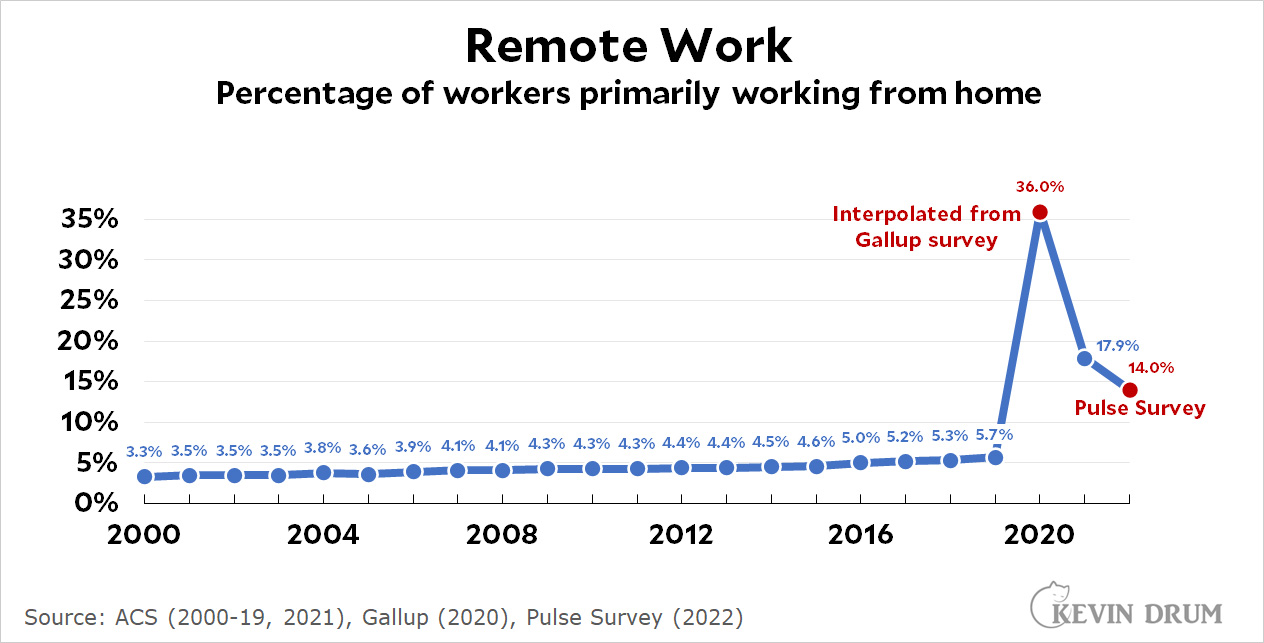Here's some weird shit based on responses to the American Time Use Survey:
 Sadly, there's no time series for this since no one cared much about it before now. However, based on commuting microdata from its annual American Community Survey, the Census Bureau estimates that working from home hit about 18% in 2021, while their Pulse survey says it dropped further to 14% in 2022:
Sadly, there's no time series for this since no one cared much about it before now. However, based on commuting microdata from its annual American Community Survey, the Census Bureau estimates that working from home hit about 18% in 2021, while their Pulse survey says it dropped further to 14% in 2022:
 So: 34% vs. 14%. These are wildly different estimates, and I can't imagine what the reason is. What's more, the estimates for educational level are out of this world: ATUS estimates that 50% of workers with college degrees work from home on any given day. Can that be real?
So: 34% vs. 14%. These are wildly different estimates, and I can't imagine what the reason is. What's more, the estimates for educational level are out of this world: ATUS estimates that 50% of workers with college degrees work from home on any given day. Can that be real?
For what it's worth, ATUS also says there's a big difference between men and women. On average (combining all educational levels), 28% of men work from home compared to 41% of women.

A great number of companies have WFH twice a week. Some continue to have all week WFH. And the vast majority of companies allow flexible WFH, where someone will stay home working if they've got kids sick or home repairs being done. Why is 50% of the most desired workers having a benefit surprising?
Anecdote, not data, but I have a PhD and have been working 100% remotely for nearly a year since I moved out of state. I'm not surprised by these data, though.
You're misreading both data.
CPS data you drew a chart for, is 5+ days WFH. The CPS data for anyWFH is 27%. If you remove the number of non-respondents from the total, that number is 30%.
The BLS data you're citing is for any WFH.
If you're comparing apples to apples:
CPS = 30%
BLS = 34%
Combining people who check e-mail from home before heading into work with those who work primarily form home means....statistics lie. There's a difference between saying 60% of people with advanced degrees work from home or saying 60% of the people with advanced degrees take work home with them.
Could it be that people working from home are… more likely to be at home to answer the phone when a pollster calls than people who work away from home? Especially if the pollster is calling during normal business hours? And especially if their job is of the type that they still have to answer the phone during business hours even if it shows an unknown number that everyone has learned to avoid during non business hours?
Anecdote: I work from home full time and have to answer every call between 8:30-5. I’ve never answered so many “unknown caller” calls in my life, and gotten surveyed much more frequently as a result.
...why do you answer unknown caller calls? Who does that?! Presumably your work-related calls wouldn't show unknown caller?
As another commenter pointed out, these two charts are apples and oranges. The answer is right there in the chart: those who work from home (a very broad definition) and those who work primarily from home (a narrower definition).
I can't attest to the veracity of Kevin's charts, but my observation is that higher level middle and SME jobs can be done from anywhere and frequently are. C-suite folks need to be seen on the deck more often in order to maintain their leadership role. Nonsalaried employees need a gatekeeper making sure they're putting in the expected time, so they're more likely to be forced into a office. Nonsalaried workers are easier to replace, so they get short end of the WFH stick.
But there's a ton of salaried people who don't need gatekeepers, they're either producing or not. The demand for talent has created a scenario where salaried talent that's not in senior leadership (and not really interested in getting there, either) can write their own tickets. They work from wherever they like and command higher $$ because they deliver. The better you are, the more freedom you have because of market demand.
The sweet spot today is to be a SME, non-senior leadership, doing a crucial task that the company is willing pay for and bend the rules for. There's an entire class of professional workers who fit into this bucket.